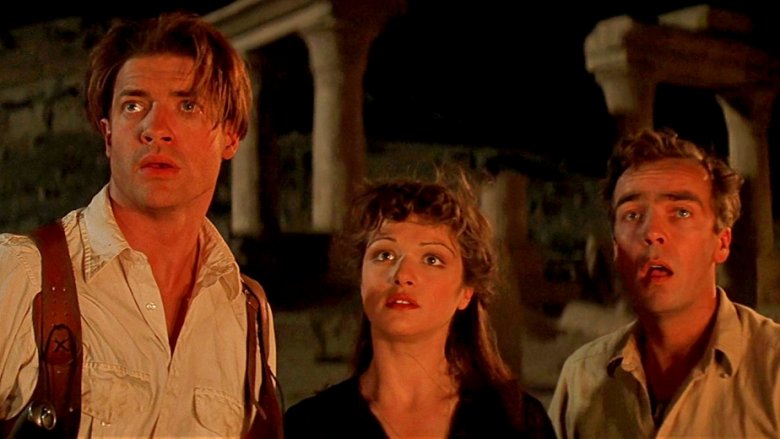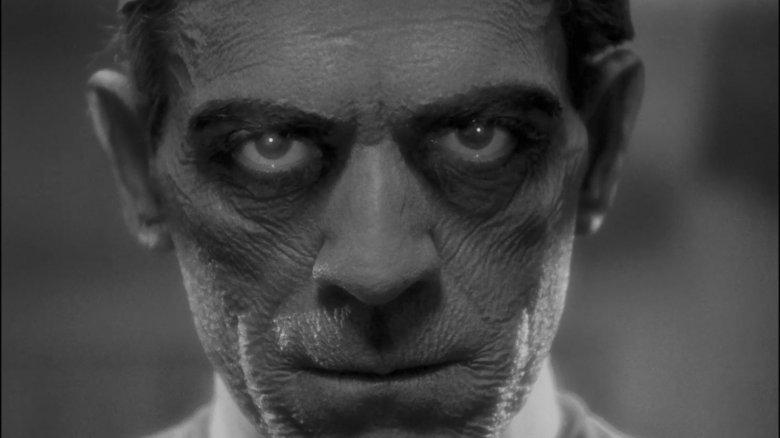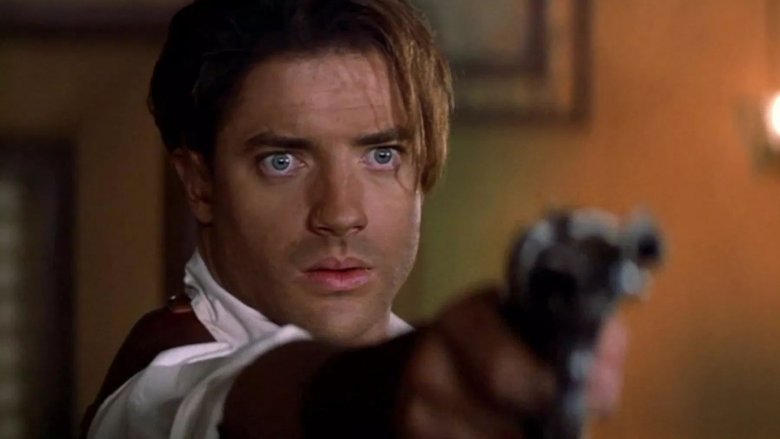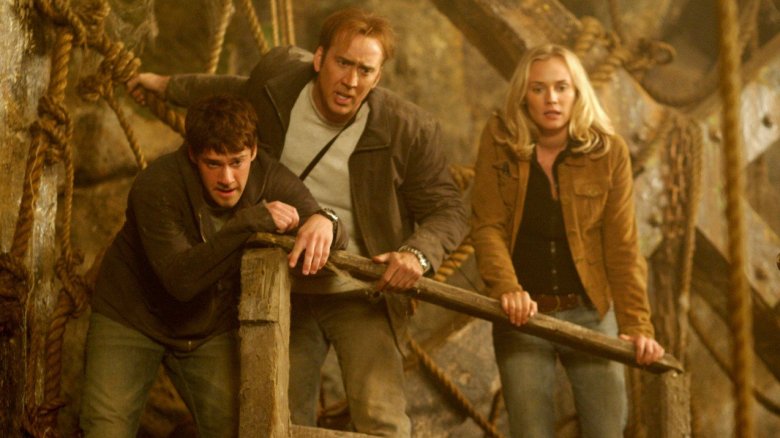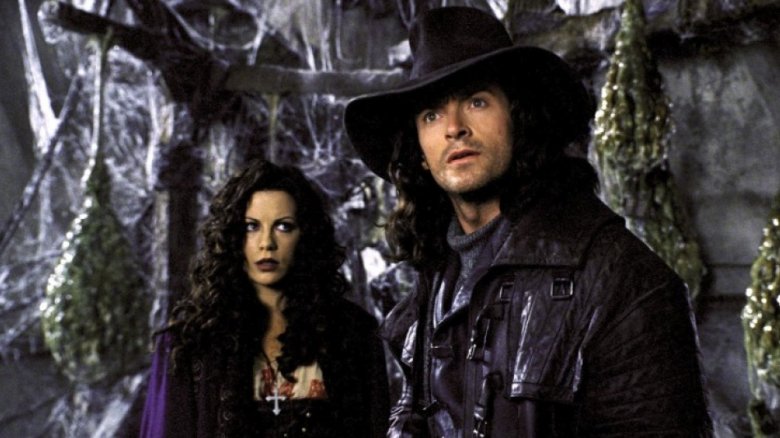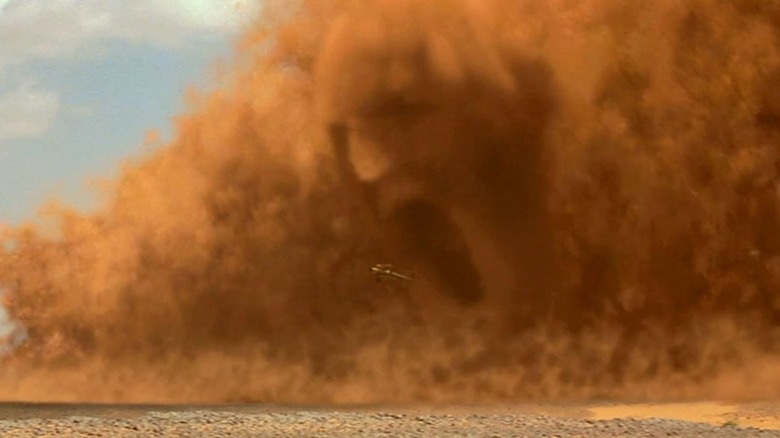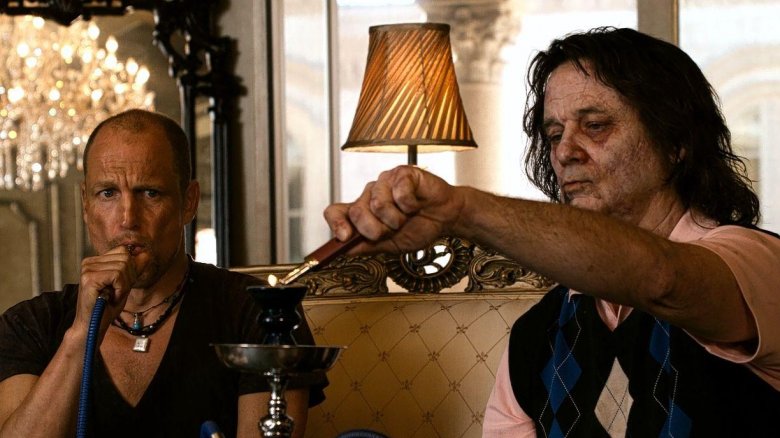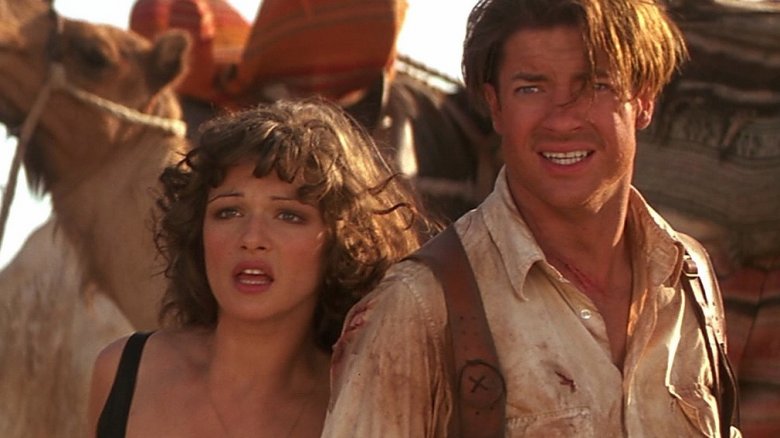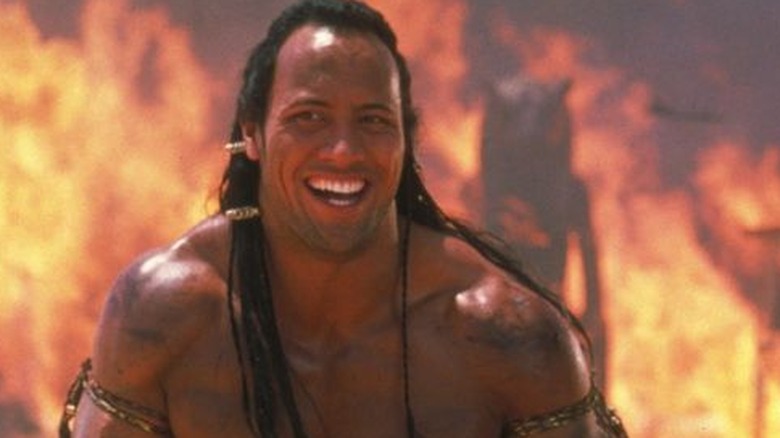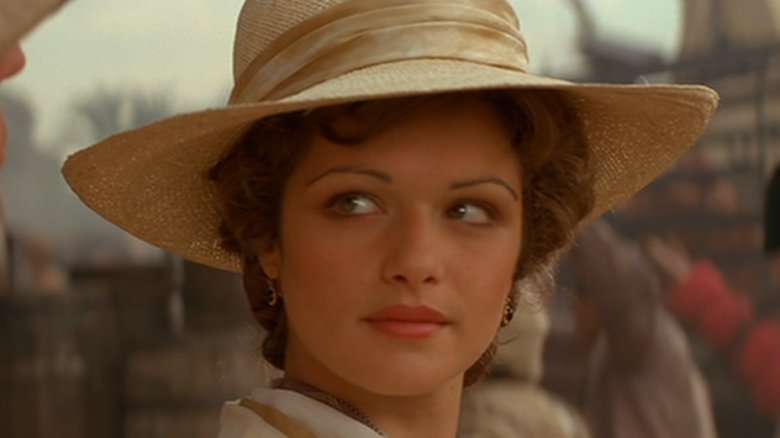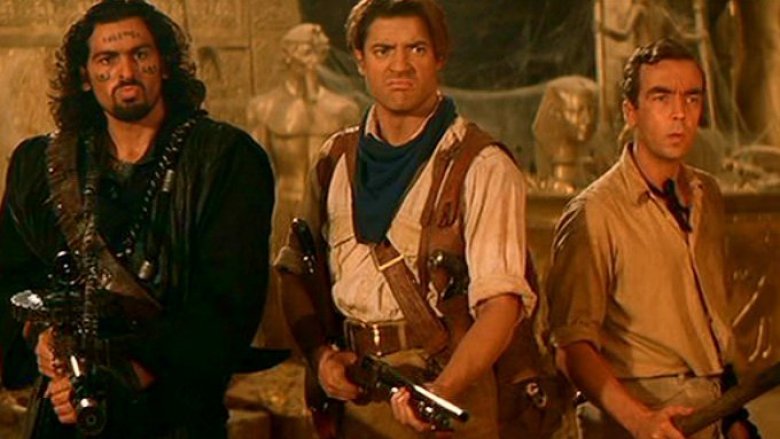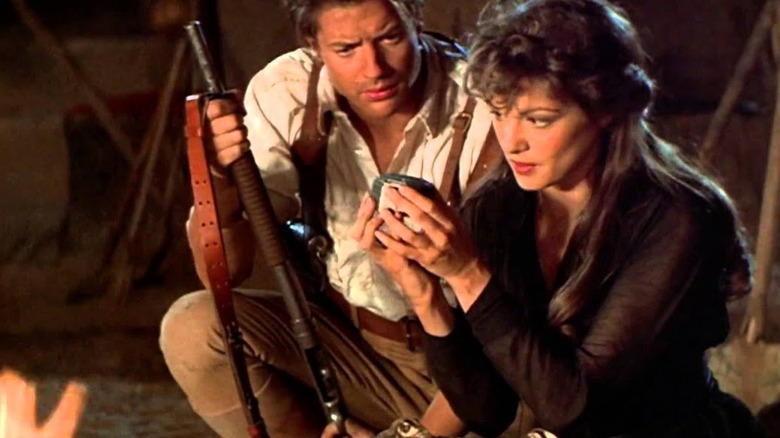How The Mummy Changed Action Movies And Nobody Noticed
Though critics gave it mixed reviews upon its theatrical release, many viewers look back on 1999's The Mummy, with nothing but fondness. The Mummy featured a talented cast, starring Brendan Fraser and Rachel Weisz, and it was the epitome of a summer blockbuster: all high-action antics, spooky curses, and the victory of good over ancient evil. But beyond being just a fun movie, The Mummy helped to change the game for many action movies that would come after it, while simultaneously taking cues from major hits of the past.
No one could have anticipated how beloved this film would become, but it has proven to be a truly timeless classic that can be watched over and over again and still provide all the same thrills. It's worth taking a look at how that unprecedented success paved the way for many of our new favorite action flicks — even if we all agree that there will never be a film quite like it again.
Remaking a classic
Technically, The Mummy is a remake of the 1932 Universal monster film of the same name, starring everyone's favorite classic monster man, Boris Karloff. It uses the original movie's story very loosely, veering away from a true horror film to something more akin to an action-horror-comedy. Remakes in Hollywood are hardly a new premise, but lately they are so thick on the ground that it's hard to pinpoint exactly when the recycling of old ideas became the main method of moviemaking. In fact, the more recent incarnation of The Mummy even sparked its own remake starring Tom Cruise in 2017. Unfortunately, it completely lacked the charm of its predecessor — because why try to change something that's already perfect?
In the years following The Mummy, many remakes which audiences may not have realized were remakes hit theaters, including Ocean's Eleven, The Manchurian Candidate, and War of the Worlds. One wonders whether the update to an old monster classic helped to pave the way for further experiments with modernizing outdated scripts for a fresh audience's eyes.
A simultaneously badass and goofy hero
Brendan Fraser continues to receive much-deserved praise for his performance as Rick O'Connell, the American French Foreign Legion officer who is handsome and charming, but also good-humored, kind, and silly. He takes his cues from action heroes of a bygone era, as well as from Harrison Ford's depiction of archaeologist-adventurer Indiana Jones — but he does it without the sexism or the self-conscious coolness. He has frequently been compared to a comic book action hero, which is apt considering how many comic book film stars seem to take a page out of the Fraser playbook. Chris Hemsworth's depiction of Marvel's Thor immediately comes to mind, as he is simultaneously an incredible, powerful god of lightning and also, later on in the Marvel Cinematic Universe, happy to lend a quip or be the butt of a joke. Chris Pratt's Starlord takes the concept even further, horsing around almost constantly until it comes to a battle, where he proves himself more useful than one would imagine.
Fraser helped break the stoic action hero mold in the '90s, and we are reaping the benefits of his innovative performance decades later. Can you imagine what The Mummy would have been like if Brad Pitt or Ben Affleck had ended up as Rick, as was originally intended? It would be a very different movie.
History is cool now
Every schoolchild wants to know why they are forced to learn history if that stuff already happened a long time ago and everyone is dead. But The Mummy helped to prove that knowing stuff about history is not only cool, it could save your life ... if you ever find yourself unearthing a mummy's curse, anyway. And following the film's success, there were several other action films that used history or historical knowledge as the basis of their plot. National Treasure in 2004, for example, played with the same concept of a history scholar (played by the inimitable Nicolas Cage) unearthing an ancient mystery, going on the run, and trying to outsmart deadly booby traps guarding untold treasures. And of course, The Mummy inadvertently spawned a small franchise of films based on the ancient Mediterranean, offered alongside more serious, dramatic historical action blockbusters like 300, Troy, and Gladiator.
Bring on the monster flicks
Since The Mummy was such a success, Stephen Sommers went on to write and direct a sequel, The Mummy Returns, which itself inspired the spin-off prequel, The Scorpion King, starring Dwayne "The Rock" Johnson in the titular role. There were several other films in this surprisingly fertile Mummy-led franchise (the most recent being the direct-to-video The Scorpion King: Book of Souls in 2018), but director Sommers decided he liked trying his hand at rebooting monster stories and gave a go at Van Helsing, which was released in theaters in 2004. It starred Hugh Jackman and Kate Beckinsale and featured more classic Universal movie monsters, such as Count Dracula and Frankenstein's monster.
That same year, Guillermo del Toro's film adaptation of Mike Mignola's comic book Hellboy hit theaters as well, tying in movie monster hunting with occultism, a touch of film noir sensibility, and a decent dose of humor.
Innovative visual effects
A staple of monster movies even as far back as the '30s has always been special effects, whether they be practical or computer generated. The Mummy chose to take an even-handed approach, utilizing both means and garnering results that at the time were nothing short of spectacular. About one-fifth of the film's $80 million budget was utilized strictly for special effects, which included digital prosthetic make-up, motion capture, key-frame animation, and stop-motion.
The mummy fight scene that was rendered in stop-motion is a clear homage to the stop-motion skeleton fight scene in 1963's Jason and the Argonauts, further solidifying the movie's deep debt to cinematic heavy-hitters of the past. Many movies at the time were beginning to use computer-generated effects to varying degrees of success, but The Mummy remains a solid example of combining multiple technologies to garner timeless results. In short, the effects hold up, even today when just about every action film has motion-capture monsters, magic, and mayhem.
Leading the way for horror-comedies
In early talks, The Mummy was intended to have Clive Barker at the helm, later switching to zombie master George A. Romero, among others. Both of these horror luminaries would have kept The Mummy scary, denying audiences the glee of watching Brendan Fraser respond to a screaming member of the legion of the undead in kind. Many will say that there is a thin line between what we find scary and what we find funny — after all, laughter is a common response to relief after experiencing trauma. So it makes sense that a legion of horror-comedies have sprung up in the aftermath of The Mummy's interpretation of what was originally presented as truly scary stuff.
In 2004, Shaun of the Dead delighted audiences with an equal parts frightening and hilarious send-up of the zombie apocalypse premise. Following suit, 2009 saw the premier of Zombieland, a surprisingly well-made and heartfelt zombie film that packed in both the action and the laughs. It seems that legions of the undead, though scary in many circumstances, are also fine fodder for some truly wacky scenarios.
An unprecedented box office success
The Mummy premiered alongside several other major blockbuster films, including franchise installments Star Wars: The Phantom Menace and Bond film The World is Not Enough. Though they did well at the box office, they are not the most lovingly remembered movies of that year. This makes The Mummy's huge box office truly remarkable as a standalone film (at the time) that promised to be nothing more than a high-powered, high-budget remake of a long-forgotten horror film that most modern audiences would probably find too old to be interesting.
We now live in a reality where most of the action films we watch are part of a sprawling franchise, but every now and then something fresh sneaks its way into top box office slots: James Cameron's Avatar (before we knew there would be a sequel), American Sniper, Inception. It's not strange to see action films performing well, but it is more unique to see ones previously untethered to any huge commercial success elbowing their way to the top in this increasingly franchise-minded movie market.
The franchise helped propel the acting careers of several wrestlers
Though the original film didn't cast any well-known wrestlers, spin-offs and sequels such as The Scorpion King helped to solidify several wrestling giants as excellent action film material. In 2001, The Rock took on the villain's role in The Mummy Returns and thus began what would become a long career in action cinema. Dave Bautista, now extremely visible in his role as Drax in the Guardians of the Galaxy movies, played the lead role in The Scorpion King 3: Battle for Redemption. And Nathan Jones, already established in films like Mad Max: Fury Road, has even dipped his toe in the cursed Nile waters, having co-starred in the most recent installment in the Scorpion King franchise, The Scorpion King: Book of Souls.
The Mummy turned away from its magic-based Egyptian antagonist toward a buff bad-boy model that won't seem to quit, allowing many wrestlers to find a place for themselves outside of the ring.
Challenging the role of the damsel in distress
If Brendan Fraser's Rick O'Connell is a refreshing break away from the action he-man stereotype, Rachel Weisz's smart, charming, and adventurous Evelyn Carnahan is a breath of fresh air for every bookish girl who doesn't feel the need to be physically strong to be worthy of heroic deeds. Weisz very much shares the spotlight with Fraser in this film, the two of them portrayed as true equals who need each other's unique skills to come out of their predicament alive.
Two years after The Mummy, Emma Watson would pick up the mantle of Hermione Granger for Harry Potter and the Sorcerer's Stone, providing an additional example of a whip-smart woman whose skills are necessary to propel the story forward and help save the day. In the 2004 movie adaptation of Lemony Snicket's A Series of Unfortunate Events, Emily Browning plays the inventive Violet Baudelaire, whose creations help her and her siblings disentangle themselves from one frightful situation after another, including her own potential marriage to a ghastly villain. And more recently, the adaptation of Madeleine L'Engle's A Wrinkle in Time sends Storm Reid, as savvy protagonist Meg, on an interdimensional journey to save her father, flipping the switch on both gender and age expectations. If the '90s Girl Power movement did anything, it helped to provide many young women with stellar examples of how to be a hero in their own way in the decades to come.
Pushing the boundaries of family-friendly violence
The Mummy has a rating of PG-13, fairly high for what was intended to be an action film for the family. And it really pushes up against that rating with some truly gruesome violence and gore. Is there anything more nightmare-inducing than the cursed scarab beetles crawling under the skin of hapless adventurers as they battle their way through booby-trapped tombs? And that one scene where Rick uses his pocket knife to wedge one of the suckers out of Johnathan Carnahan's (played by John Hannah) shoulder? Truly shudder-worthy. Toss in sword fights, shoot-outs, acid, and various plagues and it's amazing that this film got in under the R-rating radar.
This increase in violent content for impressionable audiences should come as no surprise for modern moviegoers, however. When the bulk of our media is based on comic book superheroes — originally intended for child audiences — it's a given that there will be some on-screen punching. But many of the installments in both the DC and Marvel cinematic universes present more blood, injury, and even coarse language than their PG-13 ratings should imply. And yet, children still flock to theaters to see their favorite heroes win the day, hopefully without suffering too much trauma at the depictions of rampant destruction of lives and property.
Unashamed of its low art origins
One of the most endearing qualities of The Mummy is that it is an earnest film, with an earnest cast. Everyone came together to make something truly entertaining, and they did so without qualifying their work, either onscreen or behind the scenes, as "just an old monster movie remake." In an era where the Universal monster films of the '30s seem more like silly, hokey museum archive fare than fun and thrilling entertainment, The Mummy basks gloriously in the timeless charm of some good old-fashioned monster shenanigans.
There has been a cultural shift in film viewership, away from exclusively high-brow entertainment getting all the glory, to films based in the lower art forms of comics and B-movie cinema being recognized as masterpieces in their own right. In many ways, audiences are more sophisticated than ever, with high expectations for their media. But audiences are also more well-rounded, as well, enjoying serious drama or horror films like Get Out alongside updated cult classics like the new Godzilla: King of the Monsters. Some things will always be fun, and monsters — whether they be centuries-old mummies come back to wreak havoc on the living, or radioactive lizard kaiju from the sea — are high up on that list.
